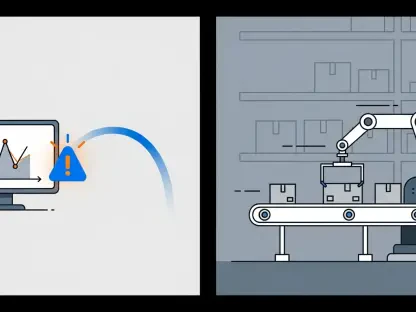In an age where technology is both an enabler and a disruptor, the intersection of artificial intelligence and cybersecurity is becoming increasingly crucial. Laurent Giraid, a leading technologist with significant expertise in AI, delves into the evolving landscape of AI-powered scams, discussing how they present both challenges and opportunities in our digital world.
Can you explain some of the major findings of Microsoft’s latest Cyber Signals report regarding AI-powered scams?
The latest Cyber Signals report by Microsoft sheds light on how artificial intelligence has been a double-edged sword in the world of cybercrime. On the one hand, AI significantly lowers technical barriers for creating scams, making it possible even for those with minimal technical skills to pull off sophisticated fraud attempts. This transformation allows scams, which previously took weeks to devise, to be accomplished in mere minutes. The report also highlights a concerning increase in fraud attempts, with Microsoft thwarting about $4 billion worth of scams last year.
Microsoft has reportedly thwarted $4 billion in fraud attempts over the past year. What measures does Microsoft implement to prevent these fraud attempts?
Microsoft employs a multi-pronged strategy to tackle the surge in fraud attempts. One core measure is leveraging AI technology across various products to enhance security. For instance, Microsoft Defender for Cloud plays a crucial role by providing robust threat protection for Azure resources. Microsoft Edge helps users avoid fraudulent websites with features like website typo protection and domain impersonation protection, using deep learning technology. Another significant step is the warning messages in Windows Quick Assist, which alert users to potential tech support scams.
How has AI lowered technical barriers for cybercriminals, allowing even low-skilled actors to generate sophisticated scams?
AI has truly democratized the capabilities needed for creating scams. Tools are now accessible that automate tasks such as scanning and scraping the web for valuable information or generating realistic product reviews and customer testimonials. This ease of use reduces the learning curve and effort required by cybercriminals, empowering even those with minimal skills to execute complex scams effectively.
In what ways has AI enabled scammers to build detailed profiles for social engineering attacks? What specific tools or techniques are used in this process?
AI plays a critical role in scraping and analyzing vast amounts of data from multiple sources on the internet, such as social media, company websites, and other public databases. These tools can compile comprehensive profiles of potential targets, which are invaluable for social engineering attacks. Techniques like natural language processing and machine learning algorithms help in identifying patterns and behaviors, making social engineering attempts more personalized and thus more convincing.
Could you elaborate on the differences between traditional scams and those enhanced by AI? How do the timelines for creating these scams differ?
Traditional scams require a significant investment of time and resources to develop, as they often involve manual crafting of content and careful planning. With AI, the process becomes automated and accelerated, allowing scammers to generate fake content, such as emails and websites, in a fraction of the time. This means what once took weeks can now be achieved in minutes, increasing the volume and frequency of attacks.
The report mentions e-commerce and job recruitment scams as growing concerns. How have AI tools changed the nature of fraud in these areas? What should consumers look out for when assessing the legitimacy of e-commerce websites and job postings?
In e-commerce, AI enables the creation of fraudulent websites that mimic legitimate ones, complete with AI-generated product descriptions and reviews. Consumers should be wary of websites with too-good-to-be-true offers and should always verify the site’s credibility through reviews and contact information. In job recruitment, AI allows the rapid creation of fake job postings and profiles. Job seekers should be cautious of unsolicited offers and always check the validity of the company and its platform before disclosing personal information.
How has the geographical origin of AI-powered scams evolved, and what reasons contribute to the activity originating from regions like China and Germany?
AI-powered scams are no longer localized; they have a global footprint. However, regions with large digital marketplaces, like China and Germany, see more activity due to the sheer volume of transactions. Large marketplaces naturally attract fraud attempts, and these regions also have robust e-commerce infrastructures that can be exploited by scammers.
What is Microsoft’s multi-pronged approach to counteracting AI-powered fraud? How does Microsoft Defender for Cloud contribute to threat protection?
Microsoft’s approach involves deploying AI technologies across their platforms to identify and block fraudulent activities. Microsoft Defender for Cloud is essential in this strategy, offering comprehensive threat protection specifically tailored for Azure resources, ensuring that potential fraud activities are detected and prevented before they can cause harm.
What innovations has Microsoft implemented in its products to protect users from tech support scams? How is Windows Quick Assist enhanced to protect users?
One of the primary innovations is the integration of alert systems within Windows Quick Assist. These alerts warn users about potential fraudulent assistance claims before granting remote access—this educates users and empowers them to make informed decisions. Additionally, Microsoft Edge’s protective measures against suspicious websites add another layer of defense.
Can you tell us more about the new fraud prevention policy introduced as part of Microsoft’s Secure Future Initiative (SFI)? How does this policy intend to make products “fraud-resistant by design”?
The Secure Future Initiative (SFI) introduces a systematic approach where fraud prevention mechanisms are no longer an afterthought but a core design element. By requiring all product teams to conduct fraud assessments during the design phase, Microsoft ensures that security considerations are integrated from the ground up, creating products that are inherently resistant to fraud.
With AI-powered scams continuously evolving, what advice does Microsoft give consumers to protect themselves? What are some specific tactics users should be cautious of?
Microsoft advises consumers to remain vigilant and critical of any digital interaction that feels rushed or demands urgency. Verifying website legitimacy before making transactions and avoiding sharing personal or financial information with unverified sources are key tactics. Consumers should also be alert for phishing attempts, which often employ AI to sound genuine.
For enterprises, what risk mitigation strategies does Microsoft recommend to prevent AI-driven scams?
For businesses, distributed AI-driven solutions that engage multi-factor authentication and deepfake detection algorithms are recommended. These strategies provide critical barriers against unauthorized access. Regularly updating security protocols and educating employees about the evolving nature of cyber threats can greatly reduce vulnerability to scams.
Finally, considering the rapid advancements in AI technology, what do you foresee as future challenges in combating AI-enhanced cybercrime?
As AI continues to advance, one of the primary challenges will be keeping pace with the speed and sophistication of new threats. The ability for AI to continually learn and adapt will mean that security measures need to proactively anticipate and counteract potential threats before they materialize. Moreover, the ethical implications of AI use will require ongoing dialogue to ensure that innovations do not leave room for exploitation.









